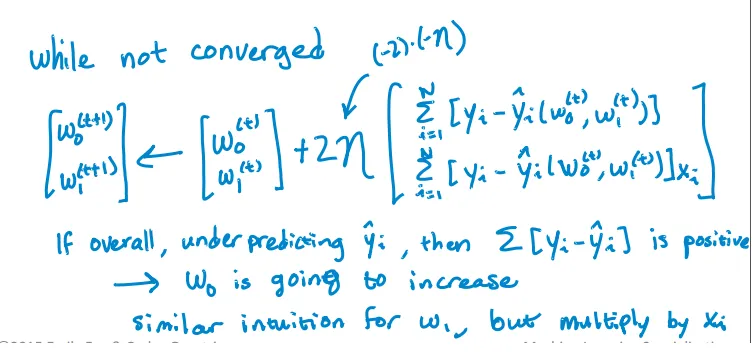我正在尝试实现这个单变量算法来查找截距和斜率:
以下是我的 Python 代码,用于更新拦截和斜率。但它并没有收敛。RSS 随着迭代而增加,而不是减少,经过一些迭代后变为无穷大。我在实现算法时没有发现任何错误。如何解决这个问题? 我已经附上了 csv 文件。
以下是代码:
import pandas as pd
import numpy as np
#Defining gradient_decend
#This Function takes X value, Y value and vector of w0(intercept),w1(slope)
#INPUT FEATURES=X(sq.feet of house size)
#TARGET VALUE=Y (Price of House)
#W=np.array([w0,w1]).reshape(2,1)
#W=[w0,
# w1]
def gradient_decend(X,Y,W):
intercept=W[0][0]
slope=W[1][0]
#Here i will get a list
#list is like this
#gd=[sum(predicted_value-(intercept+slope*x)),
# sum(predicted_value-(intercept+slope*x)*x)]
gd=[sum(y-(intercept+slope*x) for x,y in zip(X,Y)),
sum(((y-(intercept+slope*x))*x) for x,y in zip(X,Y))]
return np.array(gd).reshape(2,1)
#Defining Resudual sum of squares
def RSS(X,Y,W):
return sum((y-(W[0][0]+W[1][0]*x))**2 for x,y in zip(X,Y))
#Reading Training Data
training_data=pd.read_csv("kc_house_train_data.csv")
#Defining fixed parameters
#Learning Rate
n=0.0001
iteration=1500
#Intercept
w0=0
#Slope
w1=0
#Creating 2,1 vector of w0,w1 parameters
W=np.array([w0,w1]).reshape(2,1)
#Running gradient Decend
for i in range(iteration):
W=W+((2*n)* (gradient_decend(training_data["sqft_living"],training_data["price"],W)))
print RSS(training_data["sqft_living"],training_data["price"],W)
这里 是CSV文件。
